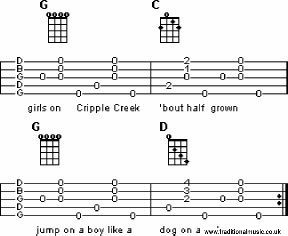A Book Of Five Strings - online tutorial
Strategies for mastering the art of old time banjo.
| Share page | Visit Us On FB |
|
play the E note on the fourth string at the second fret.
Let's try playing the verse of "Cripple Creek" using the root-five pattern.
Cripple Creek 4/4 Time Key of G |
||
|
|
||
 |
||
|
|
||
|
Try working out high and low bass patterns for other chord progressions on your own.
Chopping And Vamping
Another useful tool for working out a chord progression for playing backup is the chop.
In the basic frailing strum we are counting out each measure with the emphasis on the first and the third beats. The quarter notes (bump) in the "bump dit-ty" stand out a little more than the eighth notes (dit-ty) so the count comes out as " one two and three four and".
To play the chop we switch the emphasis over to the second and fourth beats. To do this we rest on the first beat, strum on the second beat, rest on the third beat and strum on the fourth beat.
This changes the count to something more like "one chop three chop ". |
||
|
|
||
 |
||
|
|
||
|
In order to emphasize this altered count we add in a left hand technique called vamping. To vamp all we have to do is slightly lighten up the pressure of our fingers on the strings just after the strum. The idea is to only lift up enough to stop the ringing of the chord. Your fingers stay on the strings to deaden them. This cuts the ringing of the strings short.
This is a great way to feel out chord progressions in a jam session and add a little salt and pepper into your backup playing. For maximum effect you should use closed chord positions such as the F-position G chord when "chopping". Now try playing "Cripple Creek" using the chop. |
||